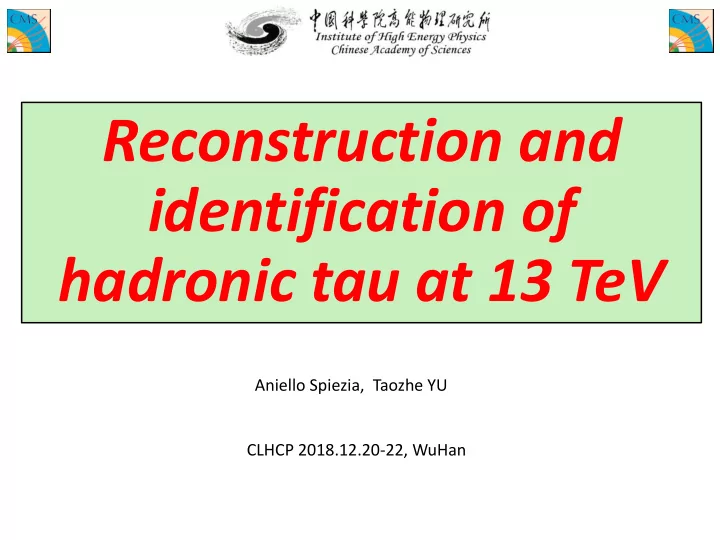

Reconstruction and identification of hadronic tau at 13 TeV Aniello Spiezia, Taozhe YU CLHCP 2018.12.20-22, WuHan
“Performance of reconstruction and identification of τ leptons decaying to hadrons and vτ in pp collisions at √s=13 TeV” • Paper published in September 2018: JINST 13 (2018) no. 10, P10005 • arXiv:1809.02816 (link here) • Algorithm developed by the CMS Collaboration to reconstruct and identify hadronically decaying τ leptons produced in pp collisions 2
• The τ lepton is the only lepton to decay into hadrons (64.8%) • In CMS hadronic τ are reconstructed and identified using the hadrons-plus- strips (HPS) algorithm New features introduced in Run II: 1. Dynamic-strip reconstruction → change the size of the strip in a dynamic way to reconstruct the decay products from the π 0 more effectively 2. Improvements in the MVA discriminants to reduce fakes from jets/electrons 3. HPS extended to reconstruct τ pairs from boosted resonances 4. Dedicated τ h identification defined at high-level triggers 3
• The τ lepton is the only lepton to PAPER decay into hadrons (64.8%) • Hadronic τ are reconstructed and In the next I will focus on identified using the hadrons-plus- boosted tau reconstruction strips (HPS) algorithm where IHEP have had a major contribution New features introduced in Run II: 1. Dynamic-strip reconstruction → change the size of the strip in a dynamic way to reconstruct the decay products from the π 0 more effectively 2. Improvements in the MVA discriminants to reduce fakes from jets/electrons 3. HPS extended to reconstruct τ pairs from boosted resonances 4. Dedicated τ h identification defined at high-level triggers 4
Heavy resonances with M ≥ 1 TeV ends with tau pairs produced close to each other from CMS-PAS- → if ΔR( τ,τ ) < 0.4, a new EXO-15-008 approach is needed • Massive boson with large pt, for example a radion decaying to HH and with at least one H decaying to a pair of τ leptons → the jets from the two τ are emitted very close to each other • The performance of the standard HPS algorithm in such topologies is poor, as it was designed to reconstruct only one single τ lepton • A dedicated version of the HPS algorithm is developed to reconstruct the two τ with large momenta emitted very close to each other • This algorithm takes advantage of jet substructure techniques 5
Algorithm workflow: • Starting from large radius jet with pt > 100 GeV • Look for two subjets inside it → they are expected to be the two τ from the boosted H • the pt of each subjet must be > 10GeV • mass of the heaviest subjet less than 2/3 of the fat jet mass • if no subjets pair is found, the procedure is repeated treating the subjet with highest mass as initial jet and splitting it into two new subjets Subjets are fed to the hadrons-plus-strips algorithm as tau candidates 6
• Comparison of the efficiencies between standard reconstruction versus boosted reconstruction in simulated events of radion → HH → bb ττ in the τ μ τ h (left) and τ h τ h (right) final state • The algorithm used for highly boosted events provides a considerably higher efficiency than the standard HPS algorithm for τ lepton pairs with pt greater than ≈ 0.5 TeV 7
• Expected probability for large-radius jets to be misidentified as hadronic τ pairs is shown for simulated QCD multijet event 8
• Performances measured in boosted Z → ττ events , with one τ decaying hadronically and the other to muon/electron • The ΔR(lep, τ ) is considered between 0.4 and 0.8 • Maximum-likelihood fit of visible mass performed in three regions • Scale factors compatible with the ones obtained for standard τ 9
• The paper describes the performance of reconstruction and identification of τ h at 13 TeV • Several improvements and new features with respect to the Run-1 algorithm (link here) have been obtained • Between them, reconstruction of τ h pairs coming from boosted resonances (Z/H bosons) • The algorithm has been shown to be a powerful tool to reconstruct τ h leptons in CMS 10
Recommend
More recommend